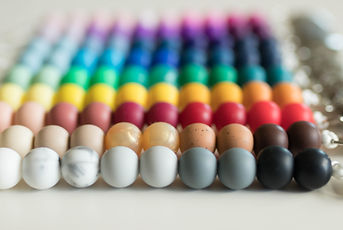Silicone: The New Plastic
Ever since the conception of plastic in the early 1900s, it’s not surprising that the versatile material has become so widely used in today's society. It can do all the things; it’s flexible, durable, washable, and can be made into pretty much any shape or size.
But in recent years, consumers have opened their eyes to the adverse effects of plastics. With more and more studies around BPA, BPS, phthalates, and microplastics, plastic is now in the glaring spotlight for being both bad for the planet and bad for our health.
That’s why silicone has taken center stage. Silicone boasts the advantageous features of plastic but without any of the nasty toxic side effects.
But how does silicone differ from plastic?
What is silicone?
Think about sinking your toes into sand. Nearly every kind of sand contains this stuff called silica, which is a form of silicon–one of the most abundant element in the crust of the Earth.
The type of silicon we’re talking about here, silicone (with an “e”), is a synthetic polymer created by mixing silicon, oxygen, and a bunch of elements (carbon and hydrogen). This polymer has been found to have a large variety of properties and can be a liquid, gel, hard, soft, and even rubber-like.
But unlike plastics, silicone has a high resistance to temperature (we're talkin' a melting point of over 1400 degrees Celsius!). Silicone also flaunts low reactivity with chemicals, it doesn’t support bacterial growth, repels water, and is resistant to UV light. These convenient attributes make silicone the new MVP material and most definitely a strong overall alternative to plastic.
Easy to clean - check.
Perfect for cooking - check.
Great for hospitals - check.
Perfection for tiny teething humans - check.
Plastic vs. Silicone: How it's made.
Crude oil is the lovely main ingredient in most plastics. Crude oil, a non-renewable resource, is extracted from the Earth, the oil's carbon compounds are modified and then transformed into plastic. Because crude oil is a non-renewable resource, that means that when it’s gone it's gone. There will be no oil left to produce new, raw plastics.
Silicon, on the other hand, is abundant (although not 'unlimited'). First, silica is extracted from the sand, heated with carbon in a super duper hot furnace to pull out the silicon. Silicon is then passed through hydrocarbons to produce a new synthetic polymer with silicon and oxygen as the foundation compound. This makes silicone a hybrid material in that it's far better in terms of resource extraction than plastic.
Talkin' Toxic Toxins
In the late 70s, the US FDA and Health Canada ruled that silicon dioxide, the backbone, raw material that goes into silicone products, was safe for food-grade applications.
This ruling was based off the theory that silicone’s key material, silica, does not contain the nasty chemicals that are found in petroleum based plastics. Furthermore, BPA and BPS, the super fun hormone-disrupting chemicals found in plastics are not found in silicone. More research on the health and safety of silicone is always welcomed but, for now, we'll happily dance to the tune of non-toxic.
Longevity and Durability
Silicone is top notch in terms of durability. Let's have a look at a plastic spatula. For the first few years, the spatula will appear in good shape but eventually that plastic will become unusable, The edges might be slightly melted, scratched, cracked or broken under too much pressure. A spiffy, silicone spatula (which often comes in brilliant colours!) can withstand huge amounts of pressure, heat (and even cold), and will resist cracking. These very convenient attributes ultimately mean you'll be saving money by not needing to replace your stuff nearly as often, cutting down on adding to the landfill and give you a sense of confidence knowing that silicone won't leach nasty chemicals like its plastic adversary.
Because silicone is so darn durable, it doesn’t easily biodegrade or decompose. Wait- isn't that a bad thing? Well, according to environmental activists, normal plastics break down into dangerous, tiny, microplastic pieces that can be accidentally ingested by wildlife. Silicone pieces are larger and are less likely to be devoured by hungry fish meaning that the nasty cascade of health problems resulting from plastic fed fish and marine life is avoided.
Recycling Silicone
Like some plastics, silicone can be recycled multiple times. But recycling silicone can be a bit tricky. It usually has to be sent to a specialized recycling center to be properly recycled. Because of this, many people opt to simply throw away silicone at the end of its life. When properly recycled, or sent to a company’s take-back program, silicone can be downcycled into an oil that can be used as industrial lubricant, playground mulch, or another lesser product. We're working with local recycling programs to implement a take-back program of our own so stay tuned!
Sources: EarthHero.com




